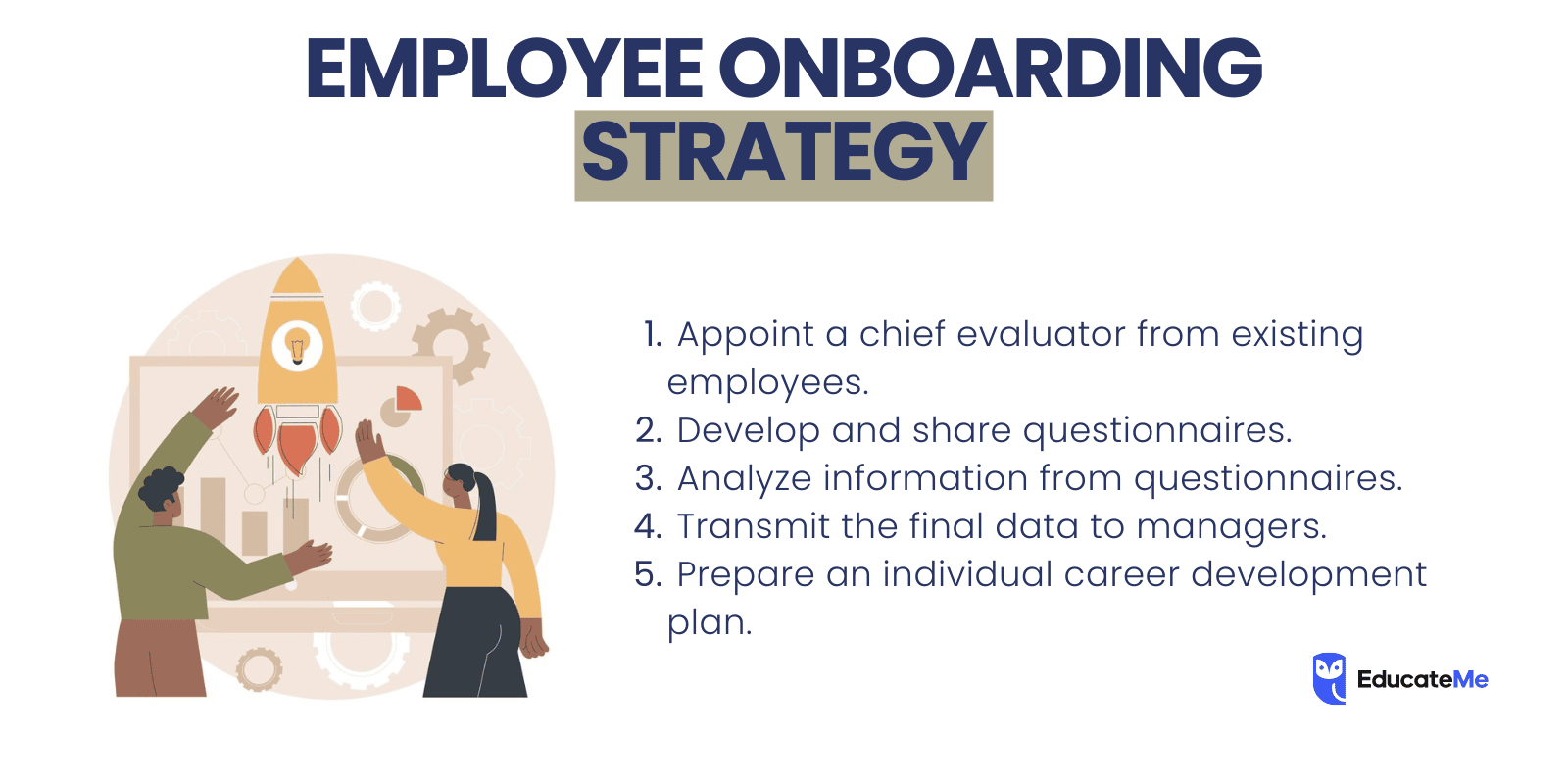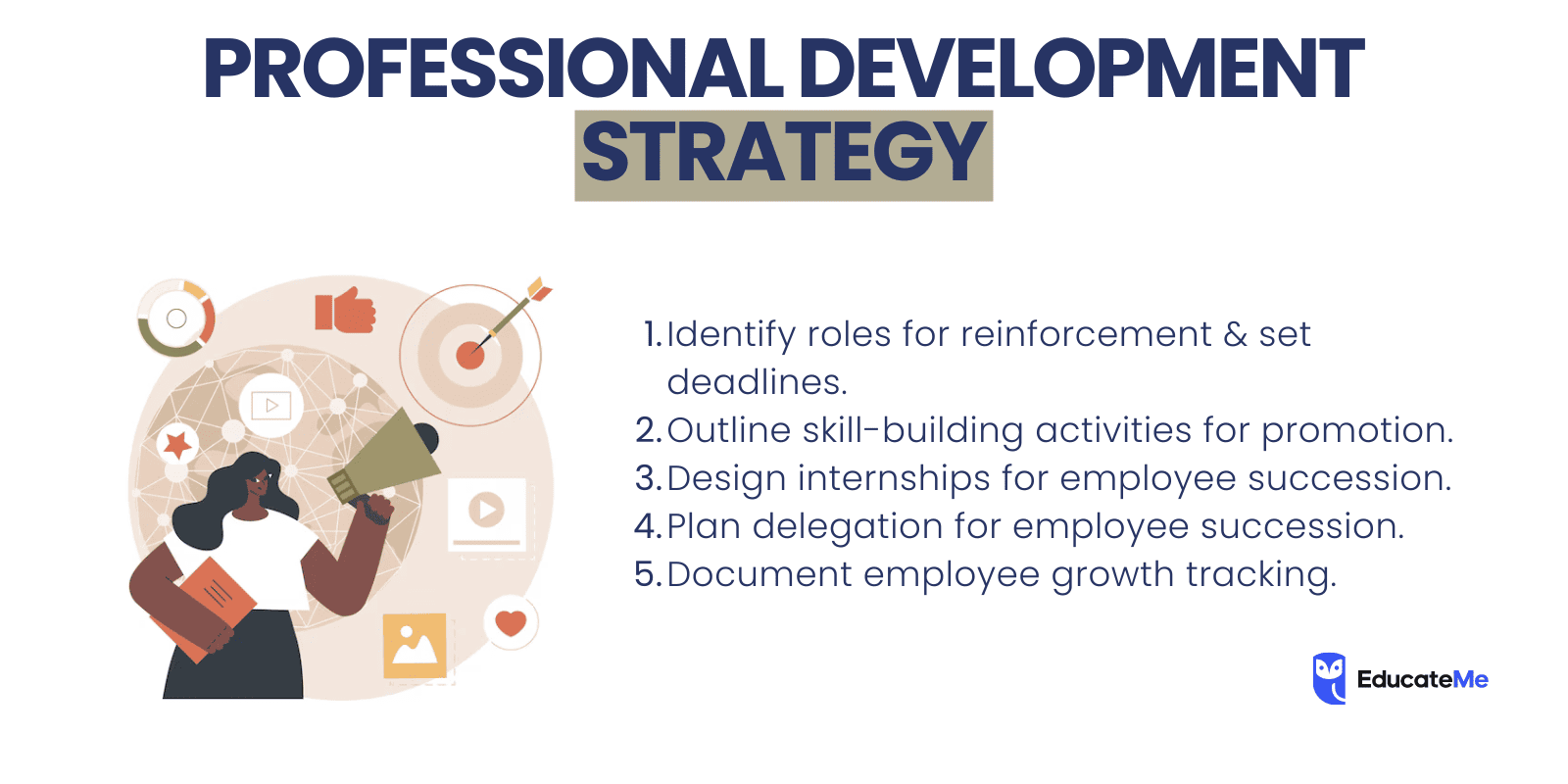o understand how well a company has organized corporate learning and development, it's enough to look at vacancies for management positions. It’s a good sign if most of them are closed due to the promotion of in-house specialists. If the company attracts managers from outside, it’s time to reconsider the corporate training strategy.
In this article, we will discover what is a corporate training strategy, how to build an effective strategy, successful examples, and much more. So, go go go 😎
What is a Corporate Learning Strategy?
A corporate learning strategy is a global plan that includes actions, activities, and tools to improve the quality of human resources following the company's overall business strategy.
To build an effective corporate learning strategy, you need to clearly understand and consider the interrelationship of strategies at all levels of management and long-term business plans.
For example, a manager wants to introduce new technologies and working methods. This means the corporate learning and development strategy would include training specialists in new work principles and retaining them in the company.
Even though a company's learning and development plan is built over a long period, it is not created once and forever. The strategies require reviews and adjustments to the changing needs of the business.
Key Components of an Effective Corporate Training Strategy
Forming a learning and development strategy framework begins with setting measurable goals. It is important to clearly state what indicators over what period need to be achieved with the help of training.

Another essential element is an analysis of the current situation within the company and among competitors. At this stage, it is significant to understand:
- how far the current situation is from the intended goals;
- what advantages competitors have;
- what methods of training and development of employees they use;
- what platforms they use for corporate training.
Choosing a platform is an essential element of building a learning strategy. It will allow hosting courses and other training materials, as well as the company’s corporate knowledge base. Test results, learning analytics & reports, bonus programs, contacts, corporate news, and other significant materials will also be stored here.
💡Highlight: To avoid the hassle of migrating this data to a new training platform, it's crucial to first pinpoint the ideal corporate training platform that aligns perfectly with the company's needs.
The collection of statistics and analytics is another mandatory element of the training strategy. With its help, you can regularly monitor whether the company is achieving its goals and, if necessary, adjust the program.
How to Build an Effective Corporate Training Strategy?
Let's look at the main steps for building a learning and development strategy for 3 main employee training types: employee onboarding, professional development program, and continuous learning.
How to Create Employee Onboarding Strategy?

Everyone knows that simply hiring an employee isn't enough. The next step is to plan a career path specifically for this employee. After all, someone may need additional training due to a lack of theoretical knowledge, someone needs practice in leadership work, etc.
To shape an employee’s career path, it is necessary:
- Determine which of the company’s current employees—rank and file and management—can give an objective opinion on what is being audited.
- Develop and share questionnaires with previously selected respondents. You can use the competency matrix as a basis. The goal is to identify the level of main indicators for the current position.
- Analyze information from questionnaires.
- Transmit the final data to managers while simultaneously informing employees directly.
- Prepare an individual career development plan for the employee.
If the company follows this algorithm, the HR service will not have to look for candidates for management and key positions on the side. The necessary personnel can be trained directly within the employing company.
How to Build a Continuous Learning Strategy?

To acquire knowledge at a university or college is not enough. New technologies appear almost every year, and the content of a certain specialty often changes completely. In practice, this means that you have to constantly learn. A systematic increase in the level of knowledge is becoming a prerequisite for successful activity in any field.
Continuous training should cover the entire employee life cycle: from hiring to dismissal. You need to start from the first day at your new workplace.
Firstly, you need to convey to employees the idea that the company values the hours spent on training.
Some people are embarrassed to study on the job because they consider it a waste of time. To prove otherwise, a manager must demonstrate an interest in learning and development.
💡Example: Ask employees how they are progressing in mastering new knowledge, what difficulties they face, and what else they would like to learn.
It is important to create a plan for continuous professional learning that is tied to the real needs of the business. It is necessary to determine immediate business goals and create a list of knowledge that employees need to achieve them. It is worth specifying in the plan exactly how the training will take place: with the help of invited specialists, on your own, or online.
The system of continuous personnel training should include both a general team development plan and individual training programs for each employee.
How can you create learning strategy that will truly be effective?
Other than that, you should communicate with people personally to find out what knowledge and skills they lack to work more effectively, and what they want to learn. It is also worth clarifying the preferred methods of learning. Based on these data, it is necessary to create a system of continuous education, which will include:
- allocated hours for training during working hours;
- offline seminars and training;
- tutors and mentors;
- online courses on LMS platforms;
- subscription to professional resources.
How to Build a Professional Learning and Development Strategy?

No matter how qualified a person is, they can’t do without a plan for developing professional skills. Years of work in any position is a huge experience and, more dangerously, a habit. There comes a time when duties are performed without interest in them, in a sense, automatically. Both motivation and efficiency are noticeably reduced. If individuals behave this way, the business as a whole will suffer.
💡Interesting Fact: Based on the latest employee training stats, 59% of employees think training directly improves their performance.
In order to find and retain talent in their field, employers are thinking about developing a personnel reserve, and improving their qualifications — that is, they are trying to plan the career growth of their subordinates.
How to correctly create a strategy that will really be effective?
- Name the employee’s competencies that satisfy both sides;
- Determine the positions that require strengthening and the deadlines within which everything must be completed;
- List what activities will allow you to develop the necessary new skills and get a new position;
- Plan introductory internships for reserve positions of a certain employee, specify the expected result from them;
- Include in your file a plan for delegating some responsibilities from a reserve position;
- In a personal conversation, consider and put on paper a schedule for monitoring and analyzing the employee’s development.
- Next, provide a mark of the fact that planned actions have been completed within a specific time frame, and provide the opportunity to leave comments.
What are the Challenges in Corporate Training and How to Overcome Them?
Exploring how people learn has been education's timeless pursuit. Today, with innovative technologies and methods, delivering, reinforcing, and assessing employee learning has significantly evolved. Yet, there are still some challenges that you can meet during organizing corporate training, and we will briefly describe them.

1. Lack of a separate budget for training
Back in 2022, more than 80% of companies, in an attempt to optimize post-Covid costs, reduced funding for corporate learning and development to a minimum or suspended such programs.
If this step made it possible to temporarily plug holes in the budget, it would play a cruel joke in the long run.
In confirmation, according to the Future of Jobs Report, six out of ten employees will need reskilling by 2027. However, retraining is impossible if the company itself neglects internal training and development of employees.
Solution: Instead of spending the company's budget on online courses or hiring an external expert to train teams, you can turn to corporate training businesses that provide a full-cycle educational process.
2. Time pressure
The Mind Tools company surveyed 2,044 people and found that 39% of those who work in the office and 54% of remote workers are familiar with this problem.
Their line managers play a key role in supporting employees. Who, if not they, can regulate a person’s workload so that he has enough time to study? Who better than a manager to motivate an employee to undergo the training necessary to work effectively? The results of the same report show that there are problems in this area of relationships:
- 43% of surveyed L&D specialists noted that managers do not want to devote time to employee training.
- A total of 84% of L&D professionals are concerned that managers are not willing to inspire employees to learn and change at work (and 27% of respondents, that is, almost a third, are very puzzled by this).
💡Interesting Fact: According to the Mind Tools 2022 report, “lack of time to learn” is the biggest challenge employees face.
Simply put, even if employees themselves are willing to learn and spend part of their working day on it, they do not find support from their managers and, as a result, cannot realize this desire.
Solution: We need to make training more accessible. Sometimes a person only has ten minutes a day to learn something. This means that suitable materials must always be at hand. A good corporate LMS can help to deal with this.
3. Lack of motivation to learn
Lack of employee involvement in educational processes and their low motivation is one of the most pressing and global problems in corporate training.
💡Interesting Fact: 67% of Hays survey respondents rate corporate learning as ineffective.
The main reason for the low involvement of employees in the corporate learning process is the passive role traditionally offered to them (when everything has already been decided for them and sent somewhere to study something).
Solution: Give the employee an active role in the educational process, which will directly affect their involvement. You can implement collaborative types of learning (social learning, peer-to-peer learning, community-based, etc.) in the educational process.
4. Difficulty measuring the impact of training
Assessing the impact of employee training can be challenging, as it’s often difficult to directly correlate the training with specific improvements in performance or business outcomes.
Nevertheless, organizations need a method to evaluate the key performance indicators of their training programs to identify areas for improvement and allocate resources more efficiently.
Solution: You may try gathering feedback from employees, monitoring changes in performance metrics such as productivity or customer satisfaction, and conducting pre- and post-training assessments to measure the knowledge and skills acquired by employees. Also, using LMS with reporting & analytics capabilities can help you to automate and visualize the results.
How Can Technology Enhance Corporate Training?
Nowadays, primary instructions for working with, say, a corporate CRM system, issuing invoices, invoicing, etc., but also any other information that may be required in the course of work are now put into digital format.

A corporate training portal may contain, for example, a selection of legislative acts that directly relate to the company’s field of activity, in which you can always find the necessary law or by-law and take the necessary wording from it when drawing up a document.
The corporate chatbot knows the answers to the most basic questions and contains information on all the most frequently encountered work issues.
A separate topic is the development of new skills in practice through the introduction of digital technologies. Thus, VR and AR technologies make it possible to organize training on how to operate various machines and technical devices even before this equipment becomes available to the enterprise.
So, what are the top 6 digital technologies for employee training now?
- User-generated content platforms (Creator’s platforms) – for creating animated videos and full-fledged online courses.
For example, Articulate and Leenda.
- Performance management – systems for assessing competencies to identify missing pieces for training. Particularly Lattice and Culture Amp.
- Voice of the employee is a survey tool designed to identify employee needs, including knowledge gaps and required training.
For example, Glint.
- Learning experience platform is a system that uses external content together with a recommendation model that allows you to generate a selection of training information that employees need.
For example, EducateMe, Absorb, and Docebo.
- Virtual or augmented reality technologies as an immersive learning tool. New digital solutions allow the company to independently develop augmented reality content from regular video and special digital tags.
For example, Strivr.
- Skills taxonomy is an opportunity to “collect” from a variety of ready-made courses, seminars, and lectures a course that will develop the necessary competencies of employees while choosing educational material that best reveals a particular topic.
For example, the new generation distance learning system SkillsDNA.
Conclusion
Developing learning and development strategies for distance and face-to-face employee training requires a lot of resources. However, over time, the costs of its creation will pay off. Most large companies include a job training strategy in their employee development plan. This allows you to develop specialists within the team.
As a result, the person not only has the necessary knowledge, but is also completely immersed in the company’s processes. Clear and transparent growth prospects allow you to retain employees in the company, reducing staff turnover.
Remember: You shouldn’t try to save time by using a ready-made template or competitors’ work. An organization's corporate strategy must be individual and take into account the company's capabilities, strengths, and weaknesses, as well as its reputation in the market.























